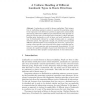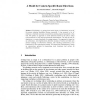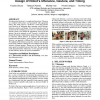KI
2008
Springer
14 years 8 days ago
2008
Springer
es of human direction giving. The process generates an abstract, relational specification of route directions, which can, for example, be externalized verbally.
GISCIENCE
2010
Springer
14 years 1 months ago
2010
Springer
Researchers from the cognitive and spatial sciences are studying text descriptions of movement patterns in order to examine how humans communicate and understand spatial informatio...
COSIT
2007
Springer
14 years 4 months ago
2007
Springer
Abstract. Landmarks are crucial for human wayfinding. Their integration in wayfinding assistance systems is essential for generating cognitively ergonomic route directions. I prese...
COSIT
1999
Springer
14 years 4 months ago
1999
Springer
Route directions are instructions, primarily verbal, that explain how to get from one place to another. The current study examines several methods for assessing the quality of verb...
SPATIALCOGNITION
2004
Springer
14 years 5 months ago
2004
Springer
Wayfinding, i.e. getting from some origin to a destination, is one of the prime everyday problems humans encounter. It has received a lot of attention in research and many (commerc...
GISCIENCE
2004
Springer
14 years 5 months ago
2004
Springer
We investigate the understanding of landmarks using a model of embedding procedures that sees affordances established on three levels. On the first level there are landmark experie...
HRI
2009
ACM
14 years 7 months ago
2009
ACM
Providing route directions is a complicated interaction. Utterances are combined with gestures and pronounced with appropriate timing. This study proposes a model for a robot that...




